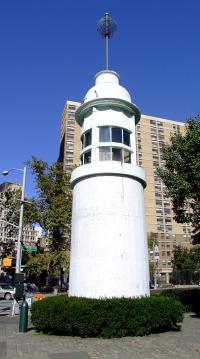 Thanks to Captain Richard Bailey for mentioning the time ball on the Titanic Memorial in the Financial District of downtown New York City. We neglected to mention it in our post “Watching the Ball Drop — the Nautical Origins of a New Year’s Tradition.”
Thanks to Captain Richard Bailey for mentioning the time ball on the Titanic Memorial in the Financial District of downtown New York City. We neglected to mention it in our post “Watching the Ball Drop — the Nautical Origins of a New Year’s Tradition.”
The memorial, a 60-foot tall lighthouse with a time ball on a staff rising above it, feels just slightly of place, as it is largely surrounded by buildings and several blocks from the East River, at the entrance of the South Street Seaport. It has not always been so landlocked, however. There is also a fascinating story behind the memorial.
In 1912, Denver socialite and philanthropist Margaret Brown rushed home from a trip to France on learning that her eldest grandchild was seriously ill. She immediately booked passage on the first available liner leaving for New York, the RMS Titanic.
When the ship struck an iceberg and sank on April 15, 1912, Brown first helped others into lifeboats and was finally persuaded to leave the ship in Lifeboat No. 6. Once in the lifeboat, she took an oar and urged that the lifeboat go back and save more people. Sources vary as to whether or not the boat went back and if they found anyone alive but Brown’s efforts at saving others were remembered.
Upon being rescued by the ship RMS Carpathia, Brown proceeded to organize a survivors’ committee with other first-class survivors. The committee worked to secure basic necessities for the second and third-class survivors and even provided informal counseling. Once in New York, Brown was active in raising support for the lighthouse memorial to those who died on the Titanic.
The lighthouse memorial was originally erected in 1913, above the East River on the roof of the old Seamen’s Church Institute of New York and New Jersey at the corner of South Street and Coenties Slip. From 1913 to 1967 the time ball at the top of the lighthouse would drop down the pole to signal twelve noon to the ships in the harbor. The time ball mechanism was activated by a telegraphic signal from the Naval Observatory in Washington, D.C.
In July 1968 the Seamen’s Church Institute moved to 15 State Street. That year, the Titanic Memorial Lighthouse was donated by the Kaiser-Nelson Steel & Salvage Corporation to the South Street Seaport Museum. It was erected at the entrance to the museum complex, on the corner of Fulton and Pearl streets, in May 1976, with funds provided by the Exxon Corporation.
Margaret Brown would go on to be active in a variety of causes including women’s suffrage and workers’ rights. During World War I, she volunteered with the Red Cross. She ran unsuccessfully for a seat in the Senate. In her later years, she also worked as an actress in New York. She died on October 26, 1932, in New York City.
Known to her friends as “Maggie,” after her death authors would dub Margaret Brown, the daughter of Irish immigrants, as the “Unsinkable Molly Brown,” highlighting her rags to riches story. In 1960, the musical, The Unsinkable Molly Brown, premiered on Broadway, featuring a highly fictionalized version of her life and of surviving the sinking of the Titanic. A movie by the same name starring Debbie Reynolds would come out in 1964.
